Let’s take a closure look at mid century modern design
Shop All Vintage Rugs | Shop All Mid Century Modern Deign Area Rugs | Shop Scandinavian Rugs | Shop Swedish Design Rugs | Shop Vintage Swedish Rya Rugs | Shop All Rugs From Scandinavia | Shop Vintage Moroccan Rugs | Shop Our Minimalist Rug Collection
What does “mid century modern” mean?
The term “Mid-century modern” refers to a design and architectural style that emerged in the mid-20th century, roughly between the 1930’s and 1960’s. It is characterized by a focus on simplicity, functionality and the integration of nature with the built environment.
The term “mid-century” refers to the middle of the 20th century, while “modern” reflects the design philosophy of the time, which emphasized clean lines, organic forms and a departure from the ornate and decorative styles of the past. This style was influenced by various movements, including the Bauhaus school, Scandinavian design and the International Style.
Mid-century modern design is known for its emphasis on open floor plans, large windows that bring in natural light and the use of materials such as wood, glass and steel. The furniture often features sleek, minimalistic designs with simple geometric shapes and a combination of natural and man-made materials.
In addition to architecture and furniture, mid-century modern design influenced other areas such as industrial design, graphic design and even popular culture. Today, it remains a popular and enduring style that is often associated with a sense of timeless elegance and a blend of comfort and functionality.
*** As a side note, when abbreviated, the term “mid century modern” is MCM (many companies will use MCM rather than type put the full “mid century modern”).
What is the time period of mid-century modern?
The time period of mid-century modern typically spans from the 1930’s to the 1960’s. It emerged as a prominent design and architectural style during this era and gained popularity primarily in the United States of America but also had influence globally. The term “mid-century” refers to the middle of the 20th century, placing the timeframe within these decades. However, it’s worth noting that the exact dates and duration can vary slightly depending on different interpretations and regional contexts.
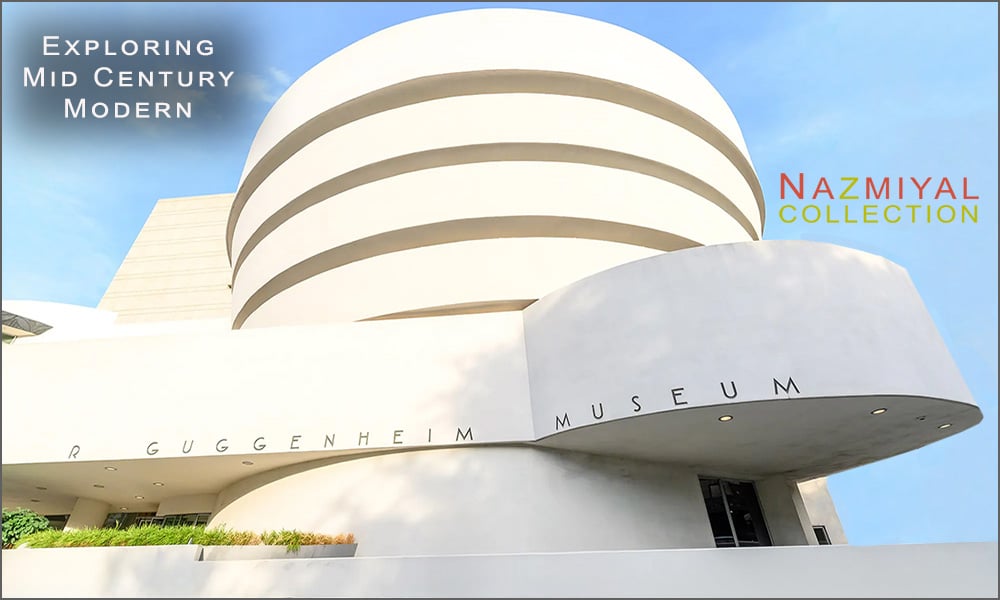
Exploring The Mid Century Modern Design Style
What are the elements of mid-century modern?
Mid-century modern design is characterized by several distinct elements that contribute to its unique aesthetic.
Here are some key elements commonly found in mid-century modern:
- Clean Lines: Mid-century modern design emphasizes clean, straight lines with minimal ornamentation. Furniture, architecture and decorative elements often feature simple, sleek and geometric shapes.
- Organic Forms: While clean lines dominate, mid-century modern also incorporates organic forms inspired by nature. Curved lines and shapes, often seen in furniture and architectural elements, add a sense of softness and harmony.
- Natural Materials: Mid-century modern design embraces natural materials, such as wood, leather, stone and natural fibers like linen and wool. These materials are often showcased in their natural state, with minimal staining or painting.
- Functionality: Functionality is a core principle of mid-century modern design. Furniture and spaces are designed to be practical and efficient, with a focus on usability and purpose. Storage solutions are often integrated into furniture pieces.
- Open Floor Plans: Mid-century modern architecture typically favors open floor plans, where spaces flow seamlessly into one another. This design concept promotes a sense of spaciousness, light and flexibility.
- Large Windows: Expansive windows are a prominent feature of mid-century modern design. These windows serve multiple purposes, including bringing in ample natural light, connecting indoor and outdoor spaces and providing views of the surrounding environment.
- Color Palette: Mid-century modern design often features a warm and earthy color palette. Shades of brown, beige, olive green, mustard yellow and other muted tones are commonly used. Bold accent colors like teal, orange and red may also be incorporated.
- Iconic Furniture: Mid-century modern is closely associated with iconic furniture designs. Mid century modern furniture by renowned designers like Charles and Ray Eames, Eero Saarinen and Hans Wegner exemplify the style, featuring sleek lines, ergonomic shapes and a blend of form and function.
- Atomic and Space-Age Influences: With the rise of the Space Age and atomic era in the mid-20th century, mid-century modern design incorporated futuristic and space-inspired elements. Atomic patterns, starbursts and other geometric motifs reminiscent of the era are often found in textiles, wallpaper and accessories.
These elements combine to create the distinct look and feel of mid-century modern design, which continues to be celebrated and admired for its timeless appeal.
Is there a difference between “mid-century” and “mid-century modern”?
The terms “mid-century” and “mid-century modern” are often used interchangeably, but they can have slightly different meanings depending on the context.
“Mid-century” simply refers to the middle of the 20th century, roughly from the 1930’s to the 1960’s. It is a broad term that encompasses various design styles and movements that emerged during that time period.

Rugs played an important part in the designs of Charles and Ray Eames.
“Mid-century modern,” on the other hand, specifically refers to a design and architectural style that was popular during the mid-20th century. It is a more specific term that describes the particular aesthetic and philosophy of design from that era.
While mid-century modern design was prevalent during the mid-century period, not all design from that time falls under the mid-century modern umbrella. Mid-century modern design is characterized by the elements mentioned earlier, such as clean lines, organic forms, natural materials and functionality.
So, while mid-century refers to the time period, mid-century modern refers to a specific design style that was prominent during that time.
Is Scandinavian design the same as mid-century modern design?
Scandinavian design and mid-century modern design share some similarities and often overlap, but they are not exactly the same.
Scandinavian design is a design movement that emerged primarily in the Nordic countries, including Denmark, Sweden, Norway, Finland and Iceland, during the mid-20th century. It emphasizes simplicity, functionality and minimalism while drawing inspiration from the natural beauty of the region. Scandinavian design focuses on creating harmonious and practical spaces with a strong connection to nature.
Mid-century modern design, as mentioned earlier, is a broader design style that emerged during the mid-20th century, primarily in the United States but with global influence. It encompasses various design movements and styles from that era, emphasizing clean lines, organic forms, functionality and a departure from ornate and decorative styles.
While Scandinavian design is considered a subset of mid-century modern design, it has its own distinct characteristics. Scandinavian design often features light and airy spaces, natural materials like wood and leather, a neutral color palette with pops of color and an emphasis on craftsmanship and quality. It places a strong emphasis on creating a cozy and welcoming atmosphere.
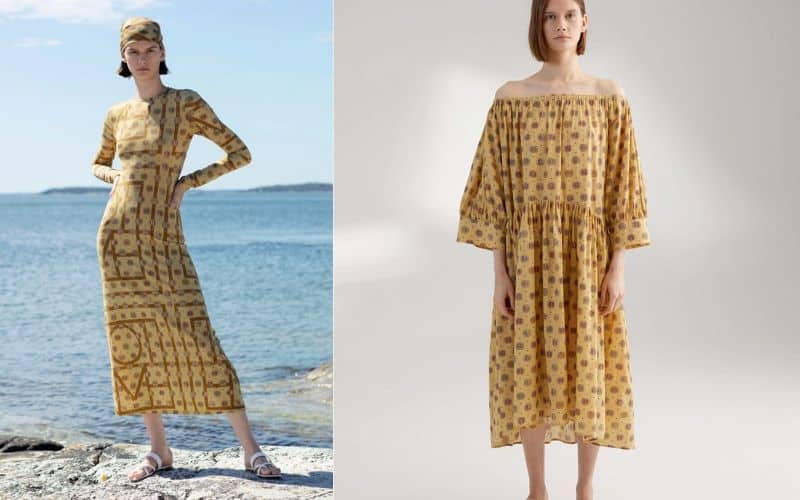
Totême’s 2019 Rug fashion is inspired by Marta Maas Fjetterstrom.
Mid-century modern design, on the other hand, can incorporate influences from various sources, including Scandinavian design. It encompasses a wider range of styles and can include bolder colors, different material choices and a more diverse range of forms and shapes.
In summary, while Scandinavian design is a subset of mid-century modern design and shares some common principles, it has its own unique identity and focuses more specifically on the design traditions of the Nordic countries.
Learn more about: The Bauhaus School and Scandinavian Design
Who were some of the most influential mid century modern designers?
Several designers had a significant impact on shaping the mid-century modern movement.
But below are some of the most influential designers from that “mid century” era:
- Charles and Ray Eames: The husband-and-wife duo of Charles and Ray Eames were pioneering designers who made significant contributions to mid-century modern design. They are known for their iconic furniture designs, such as the Eames Lounge Chair and Ottoman, as well as their groundbreaking work in architecture, industrial design and film.
- Ludwig Mies van der Rohe: A German-American architect and designer, Mies van der Rohe played a crucial role in the development of modern architecture. His use of simple geometric forms, open floor plans and innovative structural techniques became hallmarks of mid-century modern design.
- Arne Jacobsen: Danish architect and designer Arne Jacobsen is renowned for his clean and elegant designs. He created iconic furniture pieces like the Egg Chair and Swan Chair, which became synonymous with mid-century modern style. His architectural works, including the SAS Royal Hotel in Copenhagen, also exemplify the movement.
- Eero Saarinen: Finnish-American architect and designer Eero Saarinen contributed greatly to mid-century modern design with his innovative furniture designs and architectural projects. He is best known for iconic designs like the Tulip Chair and the Womb Chair, as well as architectural landmarks such as the TWA Flight Center at John F. Kennedy Airport in New York.
- Hans Wegner: Danish designer Hans Wegner created a vast portfolio of furniture designs that epitomize mid-century modern aesthetics. He is particularly known for his mastery of woodworking and his timeless chair designs, including the Wishbone Chair and the Shell Chair.
- George Nelson: George Nelson was an American industrial designer and one of the key figures in defining mid-century modern style. As the design director of Herman Miller furniture company, he collaborated with renowned designers and played a significant role in creating iconic furniture pieces such as the Marshmallow Sofa and the Ball Clock.
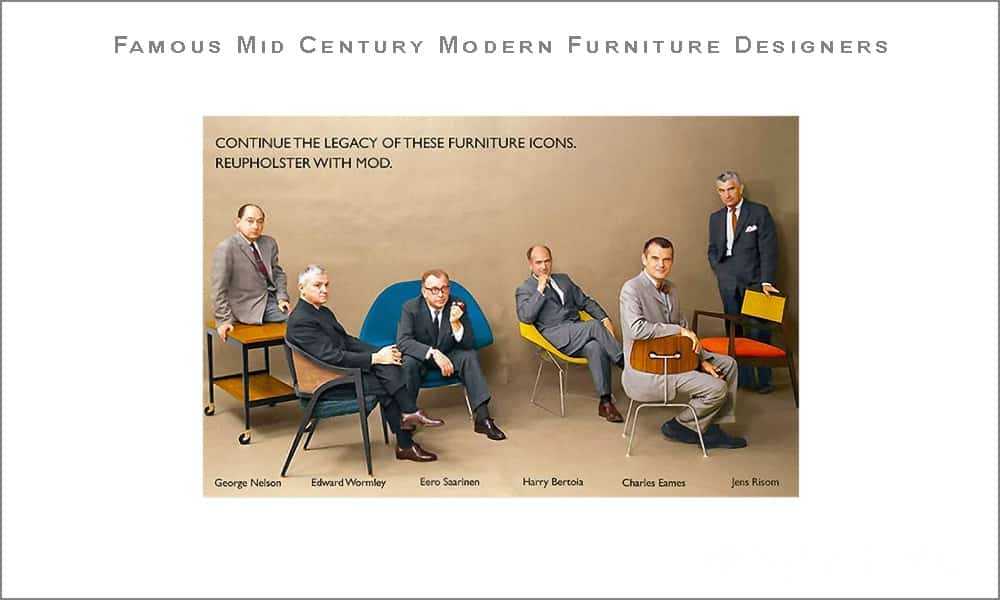
Famous Mid Century Modern Furniture Designers
These mid century designers, along with many others, left an indelible mark on the mid-century modern design style through their innovative and influential contributions. Their work continues to inspire and shape the design world to this day.
Learn more about Danish Modern Design
What do you expect to see in mid century modern interiors and home decors?
In mid-century modern interiors and home decor, you can expect to see the following features and design elements:
- Clean lines: Mid-century modern design favors clean, straight lines, whether in furniture, architectural details, or decorative elements. The emphasis is on simplicity and minimal ornamentation.
- Organic shapes: Alongside clean lines, mid-century modern design incorporates organic and curvaceous forms. These can be found in furniture pieces, such as chairs with molded plywood or curved backs, as well as in architectural details like arched doorways or sweeping rooflines.
- Natural materials: Mid-century modern design celebrates the use of natural materials, such as wood, leather, stone and natural fibers. You’ll often find furniture and flooring crafted from warm-toned woods like teak, walnut, or birch.
- Iconic furniture: Mid-century modern is renowned for its iconic furniture designs, many of which have become timeless classics. Examples include the Eames Lounge Chair and Ottoman, the Barcelona Chair by Mies van der Rohe, or the Egg Chair by Arne Jacobsen.
- Open floor plans: Mid-century modern homes often feature open floor plans that seamlessly connect different living spaces. This creates a sense of flow, spaciousness and allows for an abundance of natural light.
- Large windows: Expansive windows are a hallmark of mid-century modern design. They serve to bring the outdoors in, maximize natural light and provide a connection to the surrounding environment.
- Retro color palette: Mid-century modern interiors often incorporate a color palette that reflects the era. Warm and earthy tones like mustard yellow, olive green, burnt orange and muted browns are common. These colors may be complemented by pops of vibrant hues such as teal, turquoise, or red.
- Statement lighting: Mid-century modern design often features eye-catching more modern lighting fixtures. Sputnik chandeliers, pendant lamps with bold shapes and floor lamps with sculptural forms are popular choices.
- Minimalist approach: Mid-century modern design embraces a minimalist interior deign aesthetic, focusing on function and simplicity. Clutter is kept to a minimum and spaces are thoughtfully organized with ample storage solutions integrated into furniture.
- Atomic, retro and geometric patterns: Mid-century modern design drew inspiration from the Space Age and atomic era, so you may find atomic and geometric patterns in wallpapers, textiles and accent pieces like beautiful area rugs and cushions.
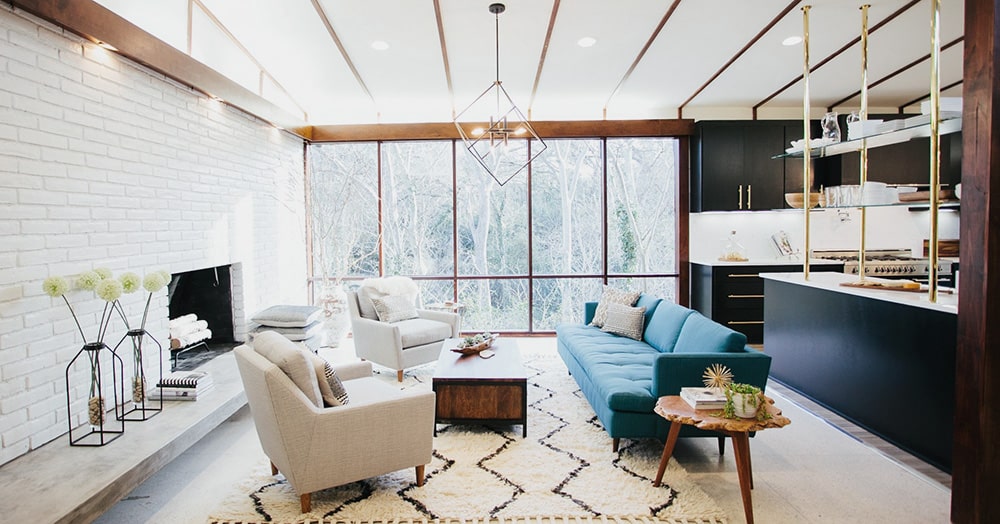
Mid Century Modern Retro Interior With Modern Moroccan Style Rug
Remember that these are general characteristics and individual interpretations of mid-century modern design can vary. The style allows for flexibility and personal expression while staying true to the core principles of simplicity, functionality and a connection to nature.
What makes a house a mid-century modern house in style?
There are several architectural and design features that can contribute to making a house mid-century modern in style.
Here are the key architectural elements that contribute to the mid-century modern look of a house:
- Flat or low-pitched roofs: Mid-century modern homes often feature flat or low-pitched roofs, which create a horizontal emphasis and contribute to the sleek, clean lines of the design.
- Large windows: Expansive windows are a defining feature of mid-century modern homes. These windows are typically large, sometimes stretching from floor to ceiling and are often arranged in horizontal bands. They allow abundant natural light to enter the interior spaces and blur the boundaries between indoors and outdoors.
- Open and airy facades: Mid-century modern homes often have open and airy facades with minimal ornamentation. The exterior walls are typically smooth and uninterrupted, sometimes featuring materials like stucco, brick, or wood siding. Cladding materials are often used sparingly to maintain a minimalist aesthetic.
- Integration with nature: Mid-century modern architecture emphasizes a strong connection with nature. This is achieved through the use of extensive glazing, sliding glass doors and the incorporation of outdoor spaces, such as patios, decks, or courtyards. This seamless integration allows for easy access to outdoor living areas and brings nature into the experience of the home.
- Geometric forms: Mid-century modern homes often showcase strong geometric forms. Rectangular or L-shaped designs are common, emphasizing a sense of simplicity and balance. Some homes may feature asymmetrical or angular elements, adding visual interest to the overall design.
- Post-and-beam construction: Mid-century modern architecture frequently utilizes post-and-beam construction, where vertical posts support horizontal beams. This construction technique allows for open floor plans with fewer interior walls and larger windows, creating a sense of spaciousness and a connection between indoor and outdoor spaces.
- Cantilevered overhangs: Some mid-century modern homes incorporate cantilevered overhangs, where parts of the structure extend beyond the supporting walls. These overhangs can provide shading, protect from the elements and create dynamic visual effects.
- Unique entryways: Mid-century modern homes often feature distinctive entryways that serve as focal points. These can include prominent front doors with bold designs or decorative elements such as stone accents or sculptural details.
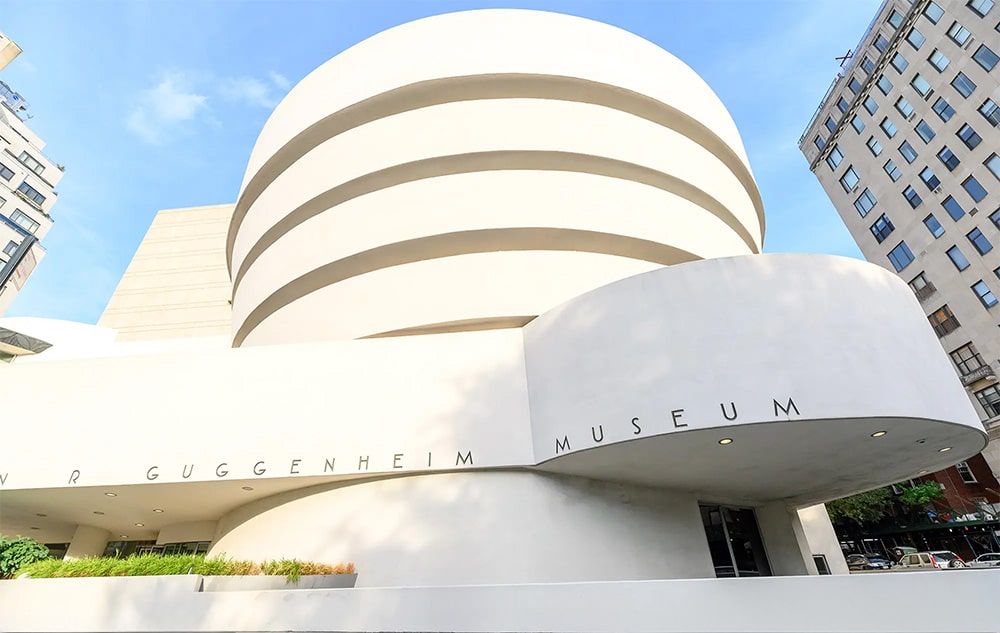
Frank Lloyd Wright Mid Century Modern Architecture Style – The Guggenheim Museum
Remember that mid-century modern architecture can vary in style and interpretation, so not every mid-century modern house will include all of these elements. However, these features are commonly associated with the mid-century modern aesthetic and contribute to its recognizable look from the exterior.
Why do area rugs from Scandinavia work so well in MCM decor?
The rugs from Scandinavia work well in mid-century modern decor for several reasons:
- Minimalist Aesthetic: Both Scandinavian design and mid-century modern design share a similar emphasis on simplicity, minimalism and clean lines. Scandinavian area rugs often feature geometric patterns and angular designs, neutral color palettes and uncomplicated designs that align with the clean and uncluttered look of mid-century modern interiors.
- Natural Materials: Scandinavian rugs are often made from natural materials like wool, cotton, or jute, which aligns with the focus on natural materials in mid-century modern design. These natural fibers add warmth, texture and a sense of coziness to the space.
- Neutral Color Palettes: Scandinavian rugs typically feature muted and neutral color palettes, including shades of gray, beige, cream and earthy tones. These colors complement the warm, earthy hues commonly found in mid-century modern interiors. The neutral colors of Scandinavian rugs allow them to blend harmoniously with other design elements in mid-century modern spaces without overpowering the overall aesthetic.
- Versatility: Scandinavian rugs are known for their versatility and adaptability. These types of area rugs can effortlessly integrate into a variety of design styles, including mid-century modern. Whether you have a vibrant or more subdued mid-century modern color scheme, the Scandinavian area rug styles can provide a balanced and grounding element to the space.
- Timeless Appeal: Both Scandinavian design and mid-century modern design have a timeless quality that transcends trends. The simplicity and enduring aesthetic of Scandinavian rugs make them well-suited for mid-century modern decor, as they align with the timeless and iconic design elements of the style.
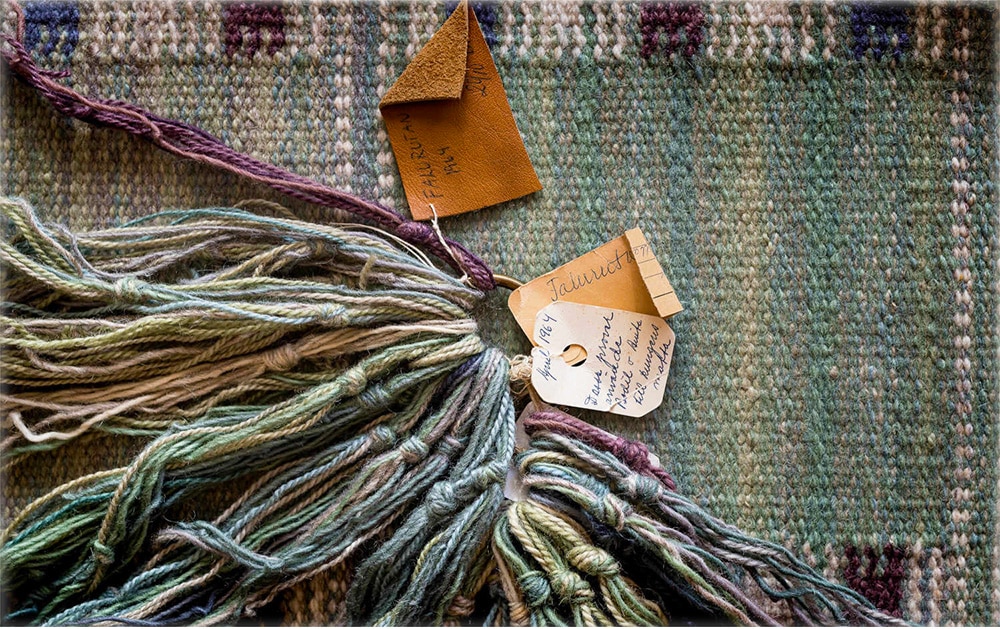
Wool Colors For Weaving A Swedish Rug At The Marta Maas Rug Atelier
Ultimately, the synergy between area rugs from Scandinavia and mid-century modern decor lies in their shared design principles of simplicity, functionality and a focus on natural materials. The harmonious blend of these elements creates a cohesive and balanced look that enhances the overall mid-century modern aesthetic.
View some of the most iconic mid 20th century area rug weavers and designers from Scandinavia:
Shop Brita Grahn Rugs | Shop Rakel Callander Rugs | Shop Gavleborgs Lans Hemslojd Rugs | Shop Marta Maas Fjetterstrom Rugs | Shop Agda Osterberg Rugs | Shop Panton Textiles and Fabrics | Shop Verner Panton Rugs | Shop Marianne Richter Rugs | Shop Ingegerd Silow Rugs | Shop Gunilla Lagerhem Ullberg Rugs | Shop Barbro Nilsson Rugs
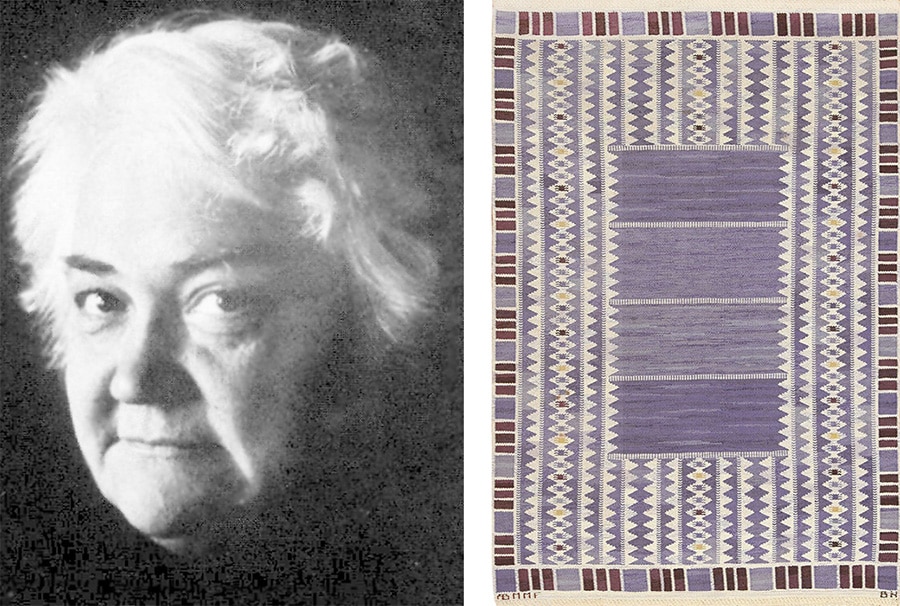
Mid Century Swedish Scandinavian Textile Designer Barbro Nilsson
Inside Jean Royère’s Mid Century Modern Design
Jean Royère’s interior designs have an iconic history that matches the biography of the man. From humble beginnings as an banker, Royère earned craftsmanship credit before creating his own definitive style – one that became a favorite of the kings of the Middle East.
From the Shah of Iran to Egyptian King Farouk and King Hussein of Jordan, Royère’s pieces could be found throughout the finest homes of the Middle East. The birthplace of antique Persian carpets, this affinity for mid-century design is perhaps unsurprising.

Illustration of a living room by Jean Royère Photo: Architectural Digest
Decorative, pretty and playful, Royère’s style is a lighthearted compliment to the ornate formality of Oriental rugs. Florals, medallions and muted colors filled royal floors, but a Royère sofa or set of chairs brought the room to life.
“The Royère style is a wonderful amalgam of bright, cheery colors, subtly organic forms and precious materials. Compact and fluid, robust and delicate, Royère’s chairs, lamps, chandeliers, sofas and desks exude a sensuous confidence, suggesting both comfort and alertness,” says the book Jean Royère, the latest retrospective look at the designer’s style.
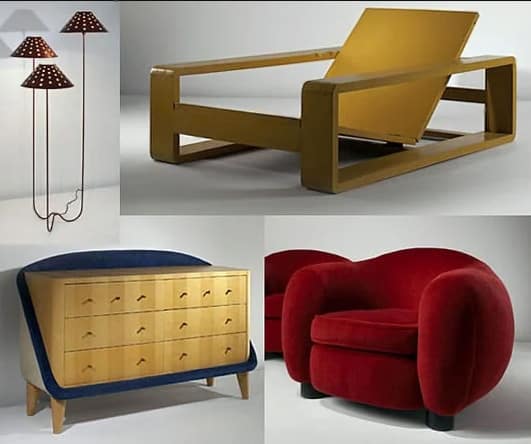
Interior Designer Jean Royere Style Mid Century Furniture
An exploration of the Royère style, the two volume edition will be unveiled on March 31 through Galerie Jacques Lacoste/Galerie Patrick Seguin. It includes interviews with designers, art historians and collectors who fell in love with Royère’s work.
The majority of the book is dedicated to Royère’s most iconic pieces, with 380 items of furniture and other creations accompanied by detailed references. But the stand-out feature is the collection of previously unpublished Royère illustrations.
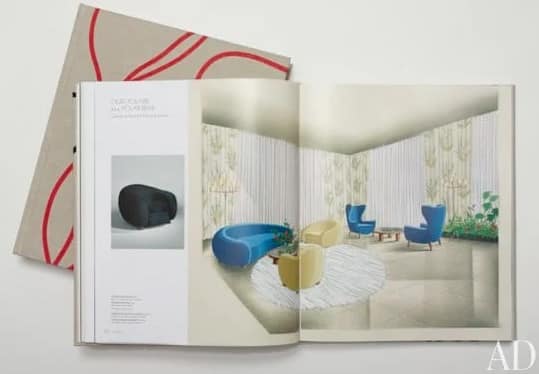
Inside Mid Century Interior Designer Jean Royere Book
He hand-sketched each of his designs individually, with an emphasis on more than just the creation of a great piece or lay-out. Royère’s philosophy centered on one-of-a-kind design. Much like the antique rugs that complimented his pieces, Royère work went beyond definition and was created only for those who “want their decoration to be personal, above all.”
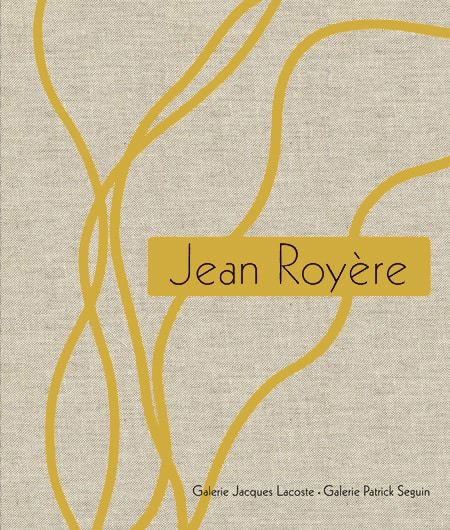
Mid Century Design Jean Royere Book
If you found this article interesting you may want to read:
Tips For Home Decorating With Scandinavian Area Rugs | Vintage Shag Pile Swedish Rya Rug History | The Swedish Rug: A Short Story About A Long History | Exploring Swedish Scandinavian Folk Art Traditions and Motifs | Choosing Retro Rugs For Your Home Decor | 5 Things You Probably Didn’t Know About Vintage Rugs | Scandi Home Decor And Scandinavian Interior Design
This interior deign blog post about the mid century modern design style was published by Nazmiyal Antique Rugs




